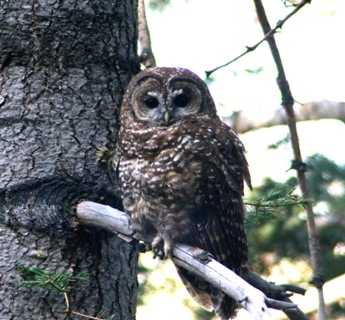SCB Urges FWS to Designate Maximum Amount of Critical Habitat
for the Northern Spotted Owl
On July 5th, SCB submitted formal COMMENTS to the U.S. Fish and Wildlife Service (FWS) on the revised critical habitat of the Northern Spotted Owl (Strix occidentalis caurina) under the Endangered Species Act.
The FWS is proposing to designate up to 13.9 million acres as critical habitat for the Northern Spotted Owl (NSO). SCB strongly supports the full designation as proposed by FWS. Unfortunately, the FWS is considering excluding up to five million acres, if not more, based on social or economic considerations. SCB’s comments note that these considerations are in conflict with the ESA’s best science mandate and that they could undermine not only the recovery of the NSO, but also the long-term effectiveness of the Endangered Species Act or all listed species.
The NSO was listed as a threatened species in 1990, and 6.8 million acres of critical habitat was proposed for the owl in 1992. This first critical habitat designation was challenged by the timber industry in court. In 2007, the FWS revised downward the NSO’s critical habitat to 5.8 million acres. While the FWS’s 2012 proposal has identified 13.9 million acres of potential critical habitat, the FWS has proposed a variety of Alternatives that could reduce the final designated critical habitat to nine million acres.
Equally troubling, the FWS is proposing that forestry “treatments” of less than 500 acres would not rise to the level of “destruction or adverse modification” of critical habitat. SCB believes that such statements have the potential to improperly influence future consultations regarding activities in the owl’s critical habitat. Finally, the FWS continues to embrace the concept of “active forestry” in the owl’s critical habitat without sufficient scientific validation. FWS’s apparent decision to move forward with untested “active management” of federally owned forest lands at the landscape level prior to validation through scientifically designed experiements and peer-review represents a potentially serious lapse in the application of the scientific process. SCB, together with The Wildlife Society and the American Ornithologists' Union sent a LETTER to FWS regarding this untested "active management" on April 2nd, 2012. Today's comments re-iterated SCB's earlier concerns regarding active management, as well as issues raised in the FWS's response letter.
In addition, the critical habitat proposal states that there may be even “greater exclusions” from the final critical habitat designation based on vaguely defined economic concerns. SCB is concurrently filing COMMENTS on the FWS’s approach for analyzing the economic impacts of designating critical habitat, arguing that, while there will be substantial losses in ecosystem services and substantial harm to spotted owls, there will be virtually no tangible benefits if habitat is excluded from the final critical habitat designation based on these economic concerns.
To address the issue of the management of critical habitat more systematically, SCB has also filed a PETITION today with the FWS to revise and strengthen its regulations regarding the designation and protection of critical habitat.
Read SCB’s comments on the critical habitat proposal HERE.
Independent Peer Review by Scientific Society Members
Provides Perspective and Advice on Northern Spotted Owl Habitat
Given the complexity of the critical habitat proposal for the Northern Spotted Owl (NSO), SCB is also participating in a peer review of the science underlying the proposed critical habitat designation with the Wildlife Society and the American Ornithologists’ Union. To preserve the scientific integrity of the peer review, the names of those scientists participating in the joint peer review by the three scientific societies have not been revealed to the SCB policy office, and their work product has not been coordinated with the SCB policy office. The joint peer review can be found HERE.
